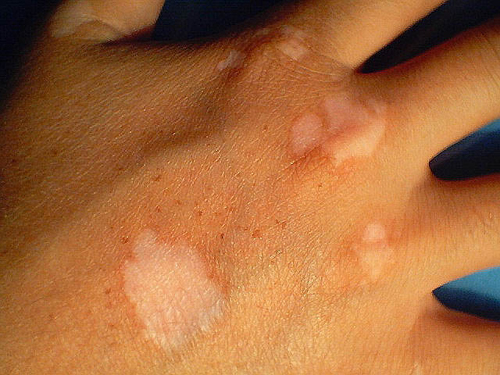Vitiligo is a type of condition where the pigment known as melanin fails to function. This pigment is extremely important in giving color to the skin, hair, and eyes. If this fails to function, then vitiligo occurs. Vitiligo will cause white patches on the skin that are irregularly shaped. Any part of the body may be depigmented, and those parts of the body which are exposed to sun for longer periods will be affected the most. It is common in areas such as the lips, mouth, face, hands, legs, and arms. Vitiligo can appear at any time or at any age, but is more likely to emerge between the ages of 10 and 30.
Vitiligo patterns
There are three known patterns for vitiligo; they are generalized, segmental, and focal. The generalized pattern is where the white patches will be seen almost on the entire body. Segmental is where the loss of color will be on one side of the body only. The focal pattern is characterized by white patches found on one or two areas only. Vitiligo is common in people who have autoimmune diseases such as diabetes and heart diseases. It affects both men and women, and affects them equally.
This condition, however, differs from one person to another and so it is very difficult to predict it. It is also very difficult to identify as there is no established pattern for its occurrence. You should, however, be aware of its known symptoms so if any of them come up, you can consult a skin doctor immediately.
Symptoms of vitiligo
The common symptoms of vitiligo are white patches on the skin, especially on the areas which are exposed to sunlight for longer periods. Other than the common areas, it may also appear – albeit less frequently – on areas around openings such as the nostrils, genitals, and rectum; along skin folds; the navel; areas around moles, and previous injury sites.
It may happen that a rapid pigment loss occurs on several skin areas, followed by a stable period, when there is no apparent pigment loss. Afterwards, further cycles of alternating stability and pigment loss are noted.
Other than the more obvious symptom of white patches, vitiligo may also exhibit the following less common symptoms: premature graying or whitening of hair; loss of color in the retina of the eye; and loss of color in the mucous membranes of the mouth.
There are also white patches caused by liver disorders and other skin infections, which are often mistaken as vitiligo by many people. In order to avoid this confusion, consult a skin expert who will examine you and perform some tests in order to determine the exact disorder. Depending on the results, the skin expert will be able to confirm if it is indeed vitiligo. Once this is confirmed, you need to undergo treatment to prevent the white patches from spreading to the entire body.
Vitiligo treatments
There are two important treatments undertaken to reduce the symptoms of vitiligo. These are medical therapies and surgical therapies. Patients should go for surgical therapies only if the medical therapies do not work.
What Are The Common Vitiligo Symptoms?,





















